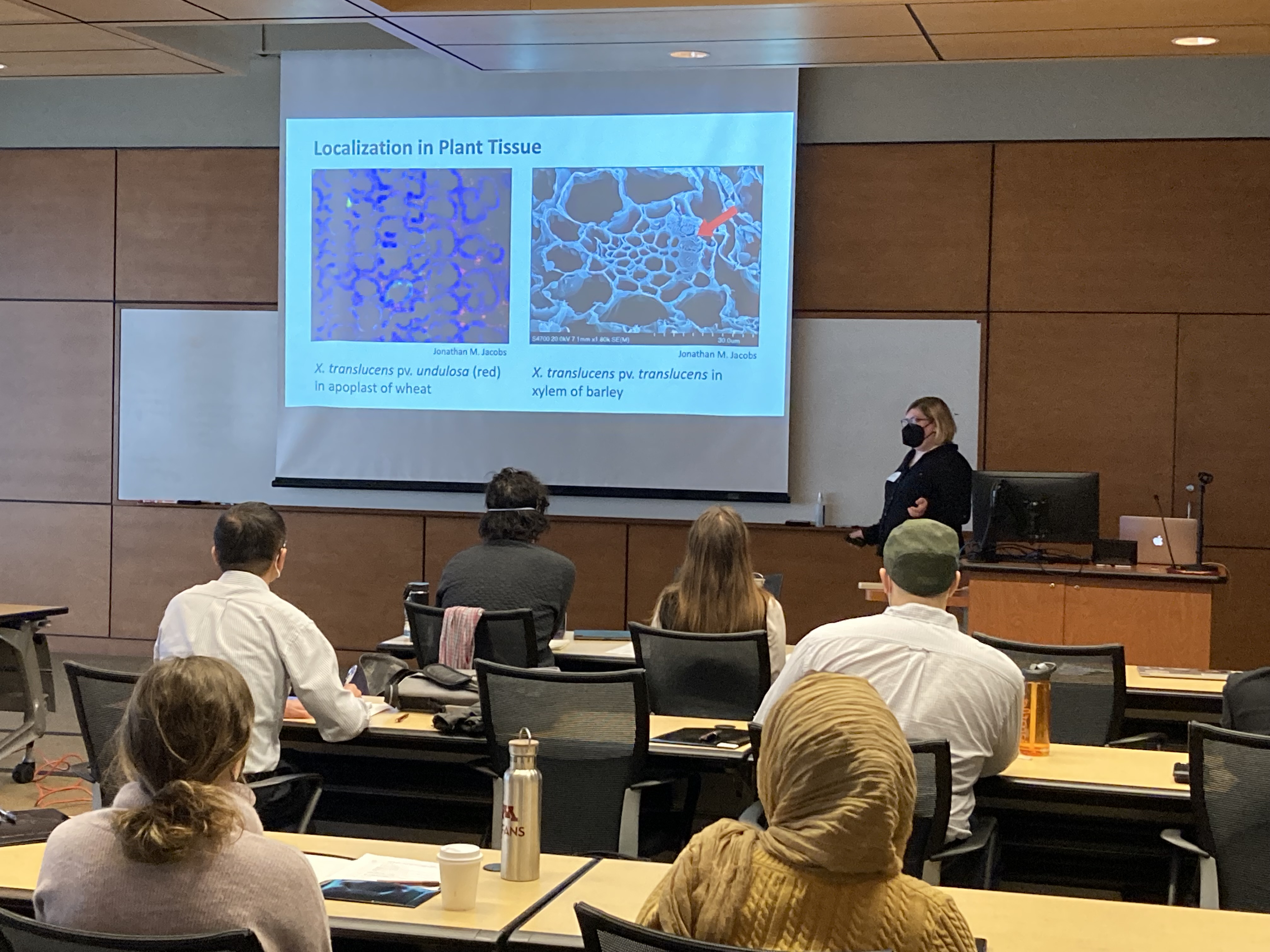Bacterial leaf streak (BLS), caused by Xanthomonas translucens pathovars, is an ongoing threat to American wheat and barley supply, but there is currently no regional or national task force for this issue. This has left plant pathologists, growers, and breeders to fight this pathogen in relative isolation, with some communication through email and publications, which can end up outdated or repetitive.
Rebecca Curland, a Researcher in the University’s Dill-Macky lab, is working to improve synergy in BLS research on a broad scale. Curland and Jonathan Jacobs, Assistant Professor of Plant Pathology at The Ohio State University, co-organized the first-ever Regional Bacterial Leaf Streak Meeting with the goal of developing a collaborative, multidisciplinary space for BLS research and education. The meeting happened on February 24-25, 2022, on the University campus in Saint Paul, with support and funding from the Minnesota Agricultural Experiment Station (MAES) and the Department of Plant Pathology.
Together at Last
Leaving the cold of Gortner Avenue in February and entering the Bacterial Leaf Streak Meeting in-person brought immediate warmth. Greeters from Minnesota and Ohio State labs offered masks, souvenir notebooks, and breakfast treats, and the bright lobby was spotted with clusters of researchers, growers, and breeders engrossed in conversation. In addition to this being the first BLS meeting of its scale, many attendees expressed excitement to be back to in-person conferences and learning opportunities, and finally having the kind of in-depth conversations best spoken side-by-side.
“There is limited control of this disease, and we’re coming together to figure this out,” said co-organizer Jonathan Jacobs in his introduction to Day One of the meeting. Colorado, Ohio, North Dakota, South Dakota, Montana, and Minnesota were all represented, and growers and breeders presented alongside university faculty, staff, and graduate students, including representatives from Molson Coors and the MN Association of Wheat Growers.
Powered by Teamwork
“These results can be used by everyone in this room,” said Mitch Ritzinger at the end of his presentation, which explained the results of his Master’s thesis done here at the University of Minnesota. Collaboration was clearly the most valuable aspect to conference attendees, and the tone of the event was one of sharing for the good of all.
Attendees took clear advantage of the minds and experiences congregated in the room. Presentations were followed by questions which launched into detailed conversations. Breakout sessions ramped into spirited discussions where comparisons of regional differences and conditions were unpacked. Several speakers wove questions for fellow researchers into their presentations, filling in knowledge gaps mid-slide. Any given table at a lunch or coffee break was just as likely to be a discussion of specific pathogen or drought response in an attendee’s home region as it was to be friendly chatter about weather, family, and pets.
Members of the University’s Dill-Macky and Steffenson labs made a strong showing in both research and hospitality. Researchers Beheshteh Zargaran and Kelsey Hyland kept the event space running seamlessly, including providing masks, food, and hydration to all attendees. Curland shared research while level-setting BLS history and basics at the top of the conference, Ph.D. student Kristi Ledman presented on BLS transmission in wheat, Professor Ruth Dill-Macky stepped in to facilitate a breakout session and a planning meeting for the future of the group, and Professor Brian Steffenson presented in conjunction with advisee Ritzinger to identify sources of BLS resistance in barley.

It’s Not “Goodbye,” it’s “See You Later”
Desire to share information, establish collaborative partnerships, create an ongoing network, and obtain shared funding gave the conference a throughline of purpose. As a companion to the in-person meeting, Curland created a shared Google drive folder with contact information, documents, and photos for all attendees, so they could bring friendships and findings home from the conference.
The group also started making plans for recurring BLS meetings, as well as pursuing funding for future collaborations and research. Developing an ongoing regional committee that includes both researchers and growers emerged as a top priority, as did planning an annual meeting for 2023.
Many thanks to Curland, Jacobs, and all meeting attendees for co-creating the future of BLS research!
